Number Recognition Systems in Practice

Surely everyone faced with the stories - “Hello, I have to go to the company that you have in the territory”, receiving in response that “the pass was not ordered,” “not allowed” or completely blind gates 4 meters in height. The rule is guarded by a very different contingent - from a not sober Uncle Vasya with a pack of dogs to real pros at important sites.
There are three tasks to be solved by IT tools:
- Most of the objects where a person controls entry can be accessed using social engineering, a banknote or, on the contrary (less often), not entered due to a number of reasons related to human factors. It is necessary to do so that those who need to enter can always do it, and those who do not need cannot.
- In this case, mockery with passes is better to skip. Ideally, also skip the exit from the car at all. Your contact has sent information that you can - and the gate opens automatically.
- The security service must clearly control the movement, be able to find out whose car this is on the territory and see the movement of people in the facility for any period of time.
In the topic - about the evolution from the string at the entrance to the modern number recognition systems.
')
How can it be?
- If you are an employee, your car number is automatically recognized, you can pass, in fact, without stopping. The log is written, who you are and when we drove-left.
- If you are a guest, your number is also recognized (the meeting party sent a request with him), and you can also call in without stopping. If the security needs to identify the guest according to the document, you will still have to stop at the entrance or at the entrance to the building. The log is written.
- If you are an unexpected guest - you can issue a one-time pass. Information about your number will also fall into the log. Ignore you without permission on the basis of only one opinion of protection will not work.
- If an abnormal situation arises, you can easily pick up the data in a couple of minutes by car number (whose wheelbarrow blocked the passage?), By arrival time (who called in today from 8 to 9 am?) And other parameters.
How does the entry usually work?
At the entrance to the territory is usually worth a checkpoint (CAT). Most often it is a structure for placing security or security officers in it, plus various combinations of underrun obstacles or pillars (bollards), automatic-controlled gates, “falling trees” (der Schlagbaum literally translates from German), remote controls and remote controls for control these things, readers of various ids.

This is what a typical checkpoint on standard objects looks like (photo from Yandex.Maps)
For example, there is a small size checkpoint booth, concrete blocks protecting the width of the passage, a barrier, and even under runway spikes. In this case, the management of all technical means is exclusively manual: the key fob on the opening of the barrier at the duty officer does not count.
The passage of cars on such a checkpoint is most often carried out on paper lists. Lists are compiled by call or, at best, by a letter from department heads. Here the human factor is obvious, and the opportunity to restore the picture of events even after a day is very mediocre. If any investigation is required, it will be based solely on the testimony of people. Perhaps, it will still be possible to supplement it with frames from the archive of the video surveillance system, in which you will still have to search for the necessary information, as no one puts tags with the brand or car number in real time. The result is low reliability of the reporting information and the huge time spent on the preparation of the puncture.
Three stages of PPC
- A checkpoint with a rope that is raised and lowered by a watchman sitting in a booth.
- Gearbox with any kind of electrically controlled blocking structures. It is controlled from the console at the checkpoint by a security officer or with a remote control passing by.
- A checkpoint with a barrier controlled by an access control system using personal identifiers.
It is clear that the first category does not require large cash investments. Protection of the object and the ability to reliably restore the picture of events are missing. “Registered” users pass, presenting a piece of cardboard or a sheet of paper with a printed “pass” exposed under the windshield, the rest go to the doorman and explain the purpose of the visit, then they are either passed under their word of honor or checked against a paper list.
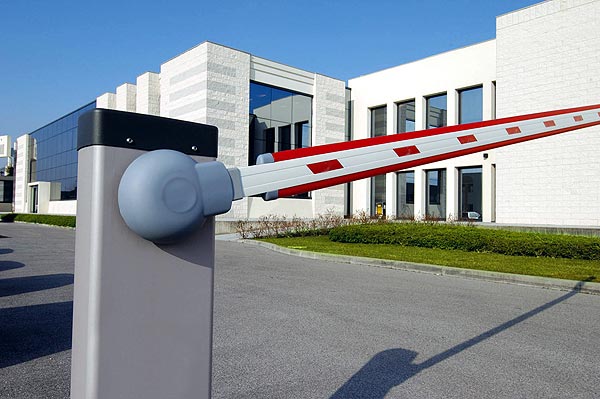
An example of equipping the entrance with an automatic barrier
The second category will require some cash investments for the purchase and installation of technical equipment. However, the level of protection is still mediocre - the human factor will play its role as a possible false admission, there is no logging of events. Access is most often carried out using radio remote controls. This category is good only because it allows "registered" users (for example, employees of the company) to enter the territory with great comfort, the rest will be missed, as in case No. 1.
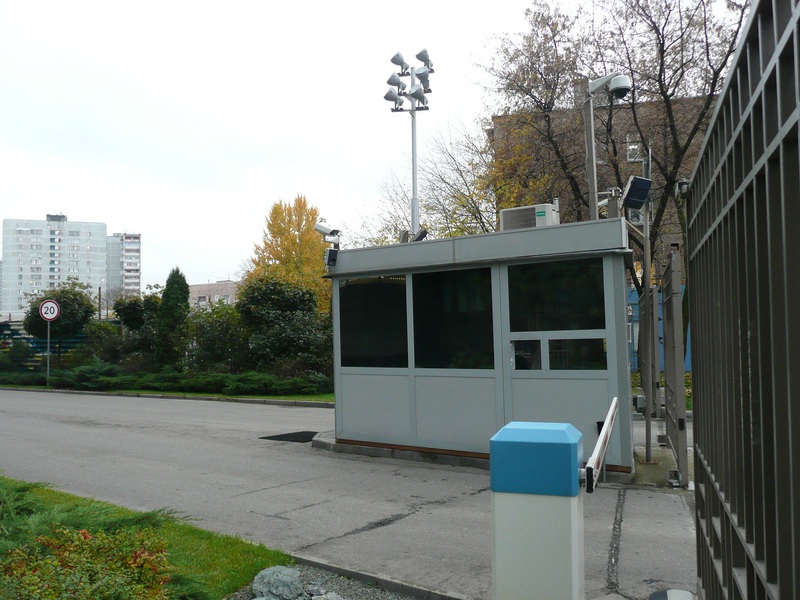
Example CAT 3 category
The third category of PPC with personal identifiers already has “intelligence”. For a start, it is possible to keep and save minutes of travel events.
True, there are also nuances here: for example, if you need to lower the glass and reach out with a card pass to the reader, this is not very convenient. You can use readers and identifiers on the basis of a radio signal with a good range - this will add comfort when traveling for registered users. True, even here the human factor will not do, since the passage of a foreign machine on request, even if it is formed electronically and stored in the system, is still done by pressing the button on the control device of the blocking device (its type and execution in this case is not are important). It turns out that this type of equipment still leaves Russian inventive mind loopholes for their own benefit.
When a few months ago, our bezopasniki realized this simple and sad fact, we began to look for a solution that can be applied both with us and at customers' facilities.
Solution in practice
Introductory : there is an office center, which has two entrances and one exit. On the territory there is a multi-tiered parking for employees and guests. Initially, entry and exit to the territory are equipped with a checkpoint with an access control system (ACS), which includes automatic barriers that are controlled by the ACS, and the ACS, in turn, uses unique personal identifiers to make access decisions. First, we worked with RFID tags that were located in cars and were issued to employees.
The condition for obtaining the RFID tag was the provision of information about the car - the brand and state number. Since the introduction of the system, this information has become personalized, i.e. started to fall under the law on personal data protection (this is a separate issue). The task of passing guests was solved through an electronic application for a one-time pass indicating the data about the car. Thus, in the system in question, accurate information about the employee’s travels was stored with reference to the point and time of travel and information about the date a visitor visited the company on a particular car.
Over time, the staff changed the car, and only the most conscious reported relevant information. The RFID tag was easily transferred to another car: as a result, a mess began to emerge: this led to the loss of actual information about the car parked on the parking lot. When at one of the levels we found a rusty nine, we went through the base of cars and realized that the employees had learned to keep unused cars in the parking lot for a long time, using the fact that there was no reference to the car driver. This, of course, is not the end of the world, but a signal about the problem - the lack of relevant information from the security service. As a result - the inability to quickly find the owner of the car in case of really serious incidents. This is how the task of tracking the passage of a specific employee on a particular machine arose.
There was the option of equipping cars with various stationary tags that are mounted on the back of the car, but this turned out to be not very useful in the calculations: if such a car is stolen or changed, the costs are too high. Plus, we would have to get the permission of each employee to fasten an incomprehensible object to the body (as a rule, in the space under the bumper).
As a result, we decided to dwell on the use of video analytics of car numbers. At the same time, it was necessary to connect the recognition to the current ACS, so that there was a bunch of human-machine. The ideal solution was a new Dutch solution, which was shown at the MIPS 2012 exhibition. What is nice, the Dutch immediately developed their own recognition system, taking into account the peculiarities of the Russian market and the market of Eastern Europe, in particular, with fine-tuning by features of numbers and fonts.
Unlike other solutions, integration was cheaper (about two times cheaper than the options existing in the market) and much simpler. The fact is that the piece of iron looks more like a “black box” - in fact, it only gives out the number that uniquely corresponds to the license plate of the car. Its interface is standard, so it is enough just to plug in a new device instead of the old radio tag identifier - and the whole system works with a bang after minimal settings.
Device
The piece is called ANPR - Automatic Number Plate Recognition. It consists of a module with a camera and LED backlight with a built-in controller, on which all analytics on number recognition “turns”, and a converter module for connecting this system to the access control system as an external reader. In total, we have only two boxes, which, for access control systems, are an ordinary reader transmitting a unique identifier. The identifier is the state number of the machine, which is converted by a special algorithm into a digital code, understandable by the ACS. The general scheme of the system - the picture at the top of the topic.
The system can work directly with any executive blocking device. In this case, you only need an ANPR module without a converter module, since ANPR has a relay output to control external devices. It is clear that with such a connection, an important part of saving access events to the ACS is lost, only the event log on the device itself remains. In a word, the desired system configuration is possible for any request and any task at no extra cost.
The manufacturer gives clear instructions on the height and distance of the installation of the system from the line on which recognition should be performed. Both devices need 24 V DC power supply, they are equipped with LAN ports for configuring modules and remote control. The ANPR module has a web interface and an integrated FTP server.
All settings are clear and easy to change, and through an FTP connection, you can download frames made when driving cars. There are settings for size, picture quality. Event recording settings allow you to store frames without rewriting for a month or set up automatic saving of frames on an external FTP server.
The settings of the image processing parameters allow you to limit the area for recognition, to prevent two state numbers from entering at once, or to set number reading parameters to speed up the transfer of information about it to the ACS.

This is how the finished installation of the system looks at
The module with a camera and backlight works in any mode, regardless of the time of day and weather conditions, and for a recognition system it is important to get a contrast picture. From this, the answers to possible questions become immediately clear - “How does it work if the number is dirty?”, “What if the number is spoiled?”. The answer lies in understanding the degree of pollution or deterioration of the room.
Examples
Below are examples of recognizable numbers (including non-standard placement, in bad weather, etc.), as well as a couple of pictures with numbers that cannot be recognized.
Please note that in the upper left corner of the frame there is information about the recognized state number, date, time and number of recognitions during the movement of the car in the field of view of the camera.

Information directly on the recorded frame
And a file with the same data is written to the internal memory card, and as a result, if you need to quickly find the data in the archive for a specific machine, you can simply search the file by the state number. The file name looks like this:
2012-08-17_09-21-41-842_CAR_H714MY71-RUS_4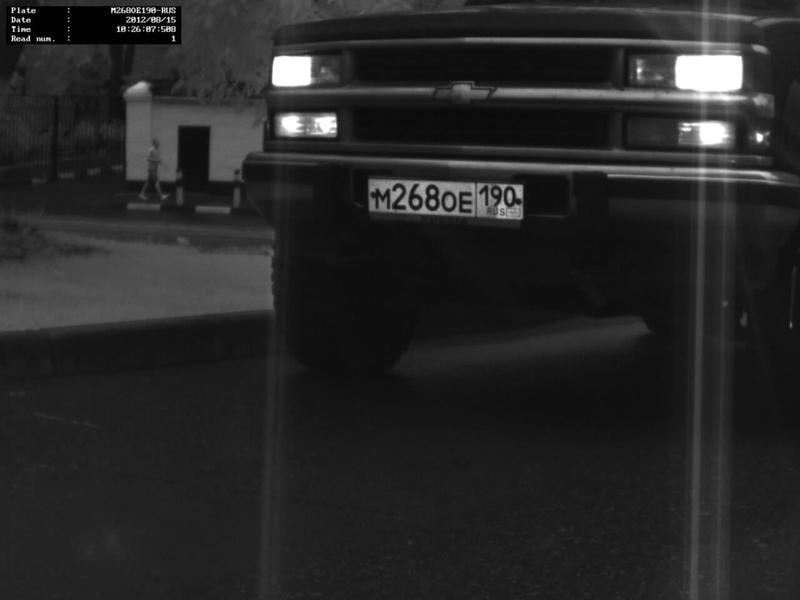
Installation of license plates is higher than that of ordinary passenger cars. Recognized.

And this is a fan of a completely abnormal installation site. Recognized.
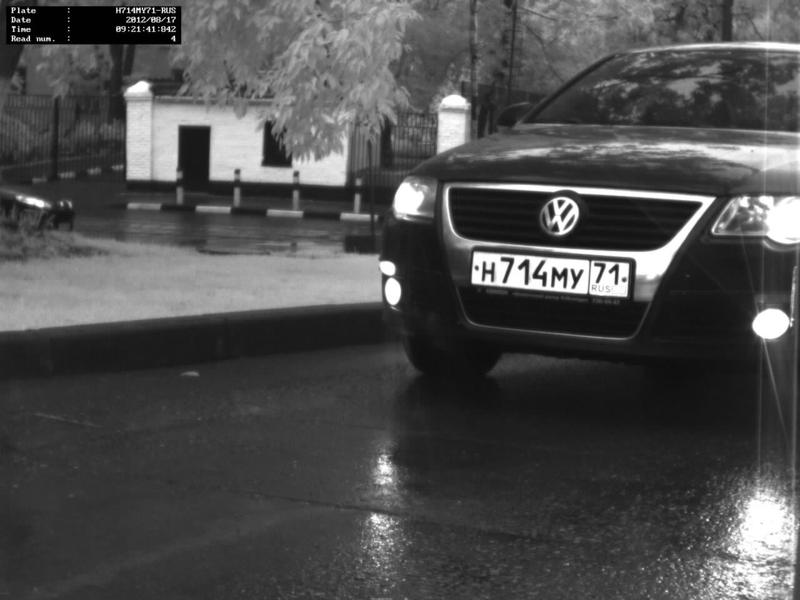
Work system in the rain. The room is clean. Recognized.
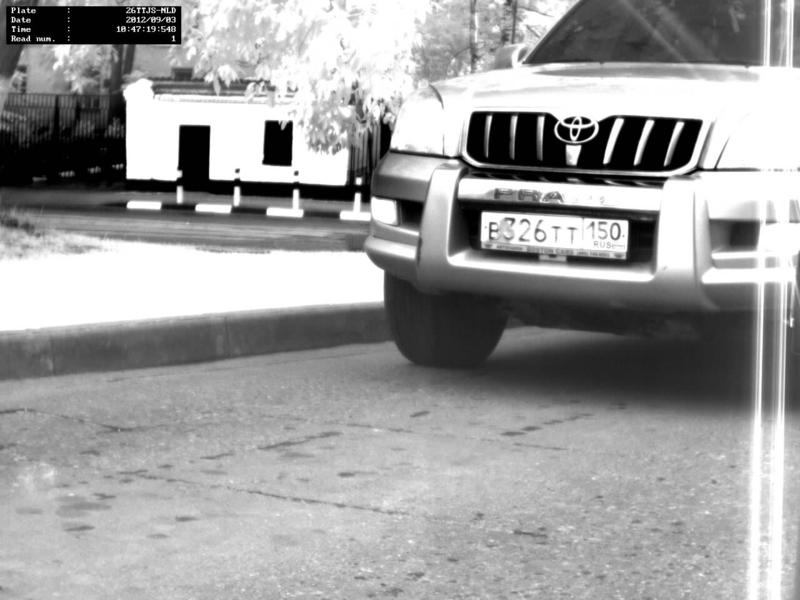
The first digit and the first letter are significantly blurred. Not recognized!

One of several bent rooms. It is recognized with an error: T 954 KP 19RUS.
Summary
The system justifies itself for any organizations and enterprises, with any number of their own and those of others, where it is important to significantly reduce the human factor, increase the relevance of information about passing cars and always be able to perform a quick analysis and get a report.
The experience of test operation during the month allowed us to significantly raise the level of relevance of the data on the vehicles in use, as the staff had an incentive to report these data, because the new system allowed us to pass faster without being distracted by pressing a button on the RFID tag.
And by the curtain, anticipating questions and suggestions on how to cheat the system, I want to remind you that this system is intended for authorized access, so from a security point of view it is more important not to miss a car with a “strange” state number than vice versa. For hopelessly spoiled numbers, there is always the option of driving through the RFID tag, but there are very few of these cars, and now the security guards know their owner by sight, and the car by the characteristic number. Fans of specifically checking the boundary conditions of the performance of the recognition system are free to choose - calmly drop into a guarded parking lot or look for a place on the street with a known risk of returning to a scratched or broken car after work (such cases, alas, have already happened).
Source: https://habr.com/ru/post/158719/
All Articles